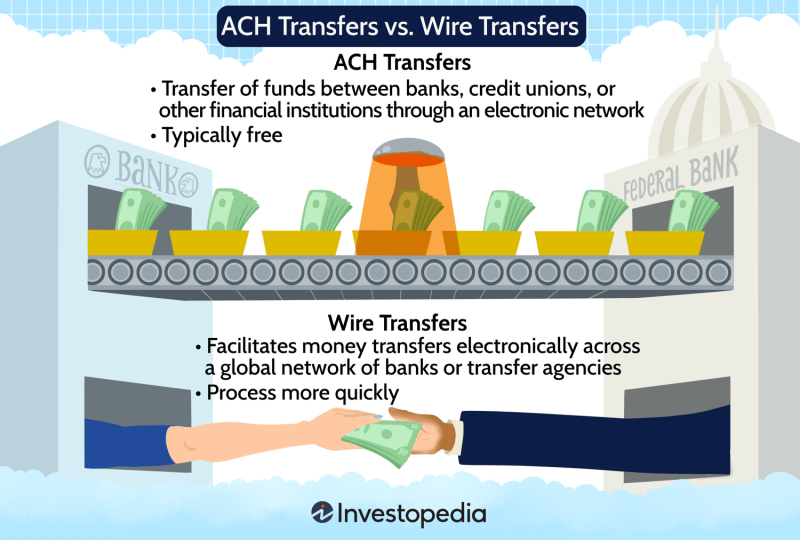
ACH Transfers vs. Wire Transfers: An Overview
Sending money from your bank account electronically is increasingly convenient, easy, and cheap. Two ways to do so are automated clearing house (ACH) transfers and wire transfers. ACH is widely used in many ways, and often low-cost or free. Wire transfers can be faster (but cost more) than ACH, and can be used for domestic and international money transfers.
Key Takeaways
- Automated clearing house (ACH) and wire transfers are both types of electronic fund transfers when sending money or paying bills electronically.
- In terms of speed, wire transfers usually process quicker than ACH transfers and may be used for international transfers, but you may be charged a fee to send or receive money.
- ACH payments are typically free and becoming faster.
- Determining when to use ACH or a wire transfer can depend on the reason for sending or receiving money and the urgency to complete the transaction.
| ACH | Wire | |
| Transaction Type | Bill pay, P2P, receiving paychecks | House closing, car purchases, sending money to friend and family overseas |
| Destination | Domestic | Domestic and international |
| Speed and Timing | Lower amounts, flexible deadlines | Larger amounts, tight deadlines |
| Cost and Fees | Free to low cost to send; few fees | Fees to send range between $25-$50 |
| Limits | Vary, but may be lower | High limits |
| Fraud | Less common fraud target | Common fraud target |
| Reversal | Possible | Very difficult to impossible |
ACH Transfers
An ACH transaction involves the transfer of funds between banks, credit unions, or other financial institutions through an electronic network. This type of transfer is used for many purposes, including processing:
- Paycheck direct deposit
- Direct deposit of government benefits or tax refunds
- Recurring debits (such as automatic bill payments)
- One-time bill payments
- International payments
- Buy now, pay later (BNPL) payments
- Healthcare claim payments
- Person-to-person (P2P) payments such as PayPal, Venmo, and Zelle
- Business-to-business (B2B) payments
Most consumers use ACH to pay bills and send money person-to-person payments because it is free for the standard transfer for a duration of 1 to 3 days in the US. Banks and third-party apps such as Venmo, PayPal, and Zelle rely on ACH to move money between friends and family or, in some cases, pay bills. ACH has also been embedded in many high-profile fintech payment apps, such as Stripe for consumer to merchant pay and for business to business payments.
In total, approximately 7.7 billion same-day ACH payments totaling $19.7 trillion were processed in the second quarter of 2022.
How ACH Transfers Work
An ACH transaction has several moving parts. How ACH transfers work can depend on whether the transaction involves a direct payment or a debit.
In simple terms, the originator or first bank initiates an ACH transfer, which is grouped with other ACH transfers. Those transactions are processed through the clearing house. Once transfers are processed for the day, they’re sent in batches to the receiving bank. The receiving bank then credits or debits the appropriate accounts accordingly.
ACH may also be known as or referred to as direct deposit, direct debit, check, EFT, and electronic bank transfer.
ACH Transfer Example
Your credit card bill needs to be paid every month, so you schedule a recurring card payment through your bank.
You log in to your online bank account or mobile banking app and authorize the payment to your credit card company. The credit card company becomes the transaction’s originator.
The credit card company sends a file with the upcoming payment details to its bank. The payment is processed through the ACH operator. The ACH operator sends a file with the payment request information back to your bank, which is the receiving depository financial institution.
Your bank sends the payment to the credit card company as scheduled. In this transaction, you are on the receiving end of a payment request.
For an ACH transaction to be processed, there must be sufficient funds in the account. Otherwise, the payment or transfer will be returned, which could trigger a fee. In addition, ACH transfers can take longer to complete due to anti-fraud protections.
Wire Transfers
A wire transfer is a transaction initiated through a bank moving funds from one account to another at an external bank. When both banks are in the U.S., this is called a domestic wire transfer. When one bank is outside the U.S., this is referred to as an international wire transfer or a remittance transfer.
Wire transfers are typically used to send large amounts of money quickly. For example, you may be asked to send your down payment funds via wire transfer if you're buying a home. You can send a wire transfer through your bank, credit union, or a business like Western Union or MoneyGram.
If you're wiring $15 or more to a foreign account from the U.S., this is known as a remittance transfer. Remittance transfers or international wires sent through a remittance transfer provider have special consumer protections, including the right to cancel within 30 minutes and the right to resolve mistakes.
How Wire Transfers Work
With wire transfers, banks communicate directly to move funds between accounts. The person sending a payment provides the bank with specific details, including:
- The transfer amount and account number you’re transferring from
- The recipient’s name, address, and phone number
- The recipient’s account number and financial institution’s wire transfer routing number (which may be different than the typical routing number) or SWIFT code for international wire transfers
- The recipient bank’s physical address
Once the bank has this information, it can process the wire transfer to deduct the requested amount from the sender’s account. This amount is then credited to the recipient’s account.
The person sending a wire transfer pays a fee, and federal law doesn't limit the bank fees charged for wires.
Once a wire transfer payment is sent and accepted, the transaction cannot be reversed.
Wire Transfer Example
Say you’re buying a home, and the amount due at closing is $42,000. Lenders often request that borrowers wire their funds for the closing costs.
You call your bank to ensure you bring what's requested. You're instructed you must make the wire request in person by 3 p.m., and bring proof of your identity. You go to your bank and provide the recipient’s name, bank, account information, and any other information your bank requests.
The bank deducts $42,000 from your money market savings account and wires it to the recipient’s bank. The bank charges you a $35 fee for the transfer. Meanwhile, the money is credited to the recipient’s account within a couple of hours.

Key Differences Between ACH and Wire Transfers
Here are general key differences between ACH and wire transfers. However, specifics can vary greatly by account type and financial institution. Banks and credit unions may have different offerings or methods for transferring cash, particularly internationally.
Transaction Type
The ACH network is most commonly used for bill payments, sending money to friends, transferring money between your accounts, receiving direct deposits for your paycheck, government benefits, or tax refund.
On the other hand, wires are often used when working with tight deadlines or large amounts, such as with real estate transactions, car purchases, or federal tax payments. They're also used for international cash transfers.
Destination
ACH is most commonly used for domestic cash transfers within the U.S., in or on a U.S. military base, U.S. embassy, and U.S. territories (Virgin Islands or American Samoa). Some international ACH transactions (IATs) may be possible depending on your bank or destination, but they're not yet widespread.
Wires can be sent anywhere in the U.S. or overseas except to countries subject to U.S. sanctions, including Cuba, Iran, and North Korea. However, some online banks do not offer the option to send money by wire internationally, only domestically.
Speed and Timing
A domestic wire transfer can be processed with money arriving the same day, sometimes in a few hours. However, you must meet deadlines to benefit from same-day processing, typically no later than 3 p.m. Eastern Time. International wires sometimes can take longer to deliver—up to 7 to 10 days.
ACH transfers are typically scheduled between the following day or up to three days later. But same-day or almost immediate is also possible in some situations. Deadlines for sending money tend to be later in the day and evening.
Cost and Fees
Your bank will not typically charge you for sending or receiving ACH transfers. Even if fees are charged, they tend to be lower than wire transfers.
However, that doesn't mean you won't ever pay fees. Standard fees include a $30-$35 NSF fee for insufficient funds, charged each attempt. You may also be charged a small fee, such as $5 if you get help placing the ACH over the phone versus online.
In comparison, sending a wire transfer tends to come with high fees:
- External domestic wire transfers: Between $25 and $30
- External international wire transfers: Between $35 and $50
- Internal wire transfers (money coming to you): Free to $15
You may pay lower wire fees with credit unions and online banks, and some prestige bank accounts waive costs associated with wires.
Limits
The amount of money you send by ACH or wire may be limited by day, month, account, or method of transfer.
In general, wires have higher transfer limits, but you may need to call on the phone or visit a branch in person to make a transfer. For example, you might only be able to send up to $500,000 to a title company for a home purchase online, but there's no limit if you visit a branch or call in.
ACH transfers tend to have lower limits, but much depends on whether you're paying a bill, sending money to another person, or sending money to an externally linked bank account. You'll likely have higher limits if sending money to a linked account.
Fraud
Both ACH and wire transfers are secure but vulnerable to scams. More scammers are using ACH fraud to divert direct deposits from government entities.
But historically, scammers used wire fraud to target unsuspecting victims. For example, you may receive an email telling you that you’ve won a contest, but to claim the money, you must first pay a processing fee using a wire transfer. You wire the money, only to receive nothing in return because the contest never existed.
Reversals
In most cases, wires cannot be reversed or stopped, and you cannot retrieve funds sent by wire after approval. So you may face enhanced security methods, such as requiring proof of your identity and request.
However, there are numerous ways an ACH can be stopped, reversed, or canceled, in certain circumstances, such as duplicate payments or an incorrect payment amount.
What Is the Difference Between ACH and Wire Transfers?
An ACH transfer is completed through a clearing house and can be used to process direct payments or direct deposits. Wire transfers allow for the direct movement of money from one bank account to another, typically for a fee.
How Safe Are ACH Transfers?
ACH transfers are regulated and designed to prevent fraudulent transactions. They can also be safer than certified checks, cashier’s checks, or personal checks. It’s important, however, to initiate ACH transfers or receive them only from trusted entities.
Are There Fees for ACH and Wire Transfers?
In most cases, ACH transfers—including online bill payments and direct deposit of paychecks—are free, while banks generally charge fees for domestic and international wire transfers.
The Bottom Line
Both the ACH and wire transfer methods have merits. Determining which is best depends on your particular needs, the type of payment you’re making, and any requirements you must meet.
Two primary differences are speed and cost. Wire transfers are sent individually and quicker than ACH transfers, which are handled in batches. Lenders may require you to wire your down payment or closing costs.
However, this extra speed comes at a cost. ACH transfers are generally free or low-cost, while wire transfers can cost anywhere from $25 to $50.
In other words, a wire transfer is your best option f you need to make an urgent payment or transfer money overseas, Conversely, for domestic payments that can wait a few days, ACH transfers usually make more sense. However, you can ask your bank if international ACH is available for the country you're sending to.
Article Sources Investopedia requires writers to use primary sources to support their work. These include white papers, government data, original reporting, and interviews with industry experts. We also reference original research from other reputable publishers where appropriate. You can learn more about the standards we follow in producing accurate, unbiased content in our editorial policy.
-
National Automated Clearing House Association. "Overall ACH Network Volume."
-
Stripe. "ACH Guide."
-
National Automated Clearing House Association. "Same Day ACH Helps Lead ACH Network to Strong First Quarter Growth."
-
National Automated Clearing House Association. "How Direct Payment Works."
-
National Automated Clearing House Association. "How Direct Deposit Works."
-
National Automated Clearing House Association. "The ABCs of ACH."
-
Consumer Financial Protection Bureau. "What is ACH?"
-
Consumer Financial Protection Bureau. "What is a Wire Transfer?"
-
Consumer Financial Protection Bureau. "What is a Remittance Transfer and What Are My Rights?"
-
Helpwithmybank.gov. "How Do I Transfer Money From My Financial Institution to a Family Member or Friend?"
-
Helpwithmybank.gov. "How Much Can a Bank Charge for a Wire Transfer?"
-
PenFed Credit Union. "How to Wire Fund for Closing."
-
National Automated Clearing House Association. "International ACH Transactions."
-
Princeton University. "OFAC Sanctioned Countries."
-
Capital One. "Wire Transfer Support."
-
Office of the Washington State Auditor. "How to Prevent ACH and Bank Fraud."
-
Federal Trade Commission. "Before You Wire Money."
-
National Consumer Law Center. "Getting Money Back for Scammed Consumers."
-
National Automated Clearing House Association. "Reversals."
Open a New Bank Account Advertiser Disclosure × The offers that appear in this table are from partnerships from which Investopedia receives compensation. This compensation may impact how and where listings appear. Investopedia does not include all offers available in the marketplace. Open a New Bank Account Advertiser Disclosure × The offers that appear in this table are from partnerships from which Investopedia receives compensation. This compensation may impact how and where listings appear. Investopedia does not include all offers available in the marketplace.



